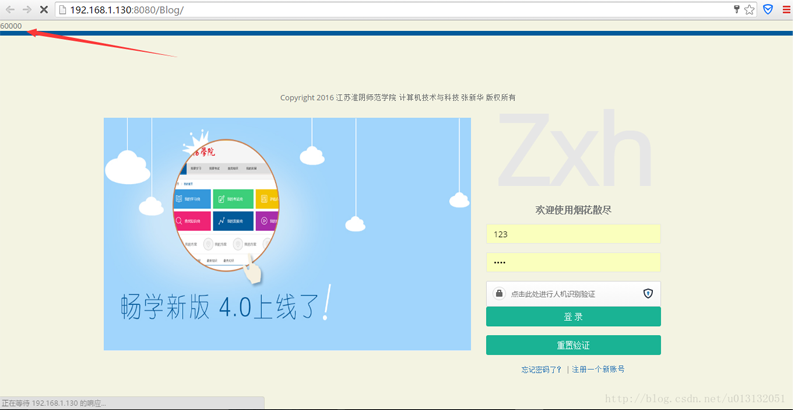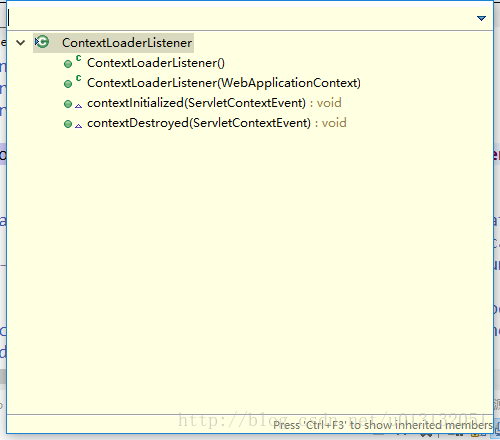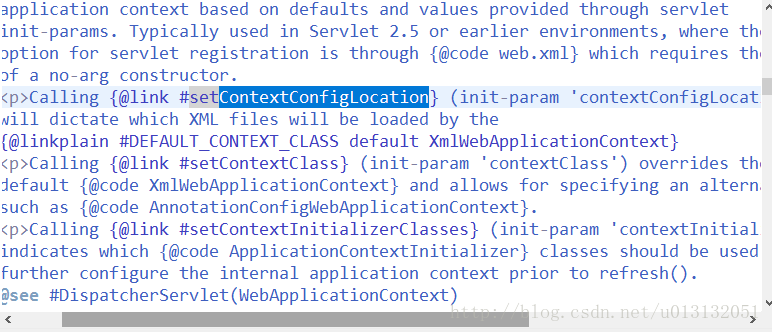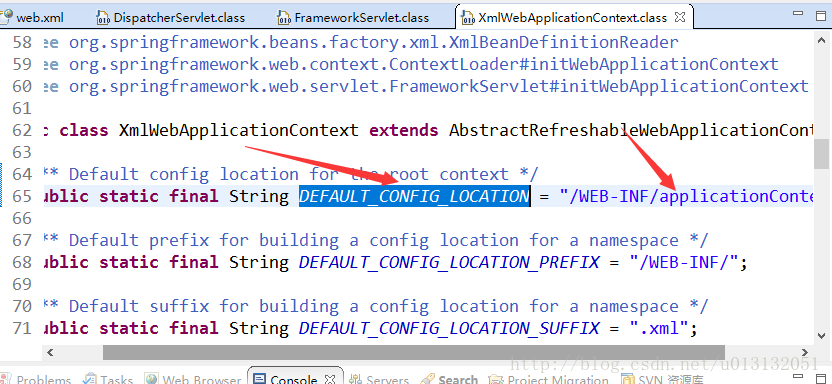Spring MVC的web.xml配置详解
spring是目前最流行的框架。创建java web项目时,我们首先会遇到的配置文件就是web.xml,这是javaweb为我们封装的逻辑,不在今天的研究中。下面我们将简单讲讲web.xml中的配置。
一、一个空的web.xml
<?xml version="1.0" encoding="UTF-8"?> <web-app version="3.0" xmlns:xsi="http://www.w3.org/2001/XMLSchema-instance" xmlns="http://java.sun.com/xml/ns/javaee" xmlns:web="http://java.sun.com/xml/ns/javaee/web-app_3_0.xsd" xsi:schemaLocation="http://java.sun.com/xml/ns/javaee http://java.sun.com/xml/ns/javaee/web-app_3_0.xsd" id="WebApp_ID"> </web-app>
二、标签介绍
web.xml中比较常见的标签以及其加载顺序为:
context-param > listener > filter > servlet
1、 <display-name>Archetype Created Web Application</display-name>
display-name 是标识项目的名称,这个不是很常用,可有可无的,或者说不需要我们去在意的东西。
2、 <context-param>
<context-param> <param-name>webAppRootKey</param-name> <param-value>60000</param-value> </context-param>
context-param 是web.xml首先加载的标签,其下子标签有param-name和param-value.
此所设定的参数,在JSP网页中可以使用下列方法来取得:
${initParam.webAppRootKey}
若在Servlet可以使用下列方法来获得:
String param_name=getServletContext().getInitParamter(“webAppRootKey”);

3、listener
<listener>
<listener-class>org.springframework.web.context.request.RequestContextListener</listener-class>
</listener>
listenter在项目开始的时候就注入进来,尽在context-param之后,所以正常我们将spring配置在listener 中,这样方法spring 初始化相关的bean。
4、filter
<filter>
<filter-name>CharacterEncodingFilter</filter-name>
<filter-class>org.springframework.web.filter.CharacterEncodingFilter</filter-class>
<init-param>
<param-name>encoding</param-name>
<param-value>UTF-8</param-value>
</init-param>
<init-param>
<param-name>forceEncoding</param-name>
<param-value>true</param-value>
</init-param>
</filter>
<filter-mapping>
<filter-name>CharacterEncodingFilter</filter-name>
<url-pattern>/*</url-pattern>
</filter-mapping>
filter起到一个过滤的作用,在servlet执行前后,像上面的配置就是在过滤servlet前将编码转换UTF-8,filter-mapping 则是将filter和url路径进行映射。其中init-param则是将初始化需要的参数传入到filter-class中从而进行初始化。filter和filter-mapping中的name必须是相同的,才能起到映射的作用,而filter-mapping 中的url-pattern则是匹配请求路径的。上面‘/*'表示过滤所有请求的servlet,如果写成‘/zxh',则过滤http://localhost:8080/项目名/zxh这个请求。
5、servlet
<servlet>
<!-- 配置DispatcherServlet -->
<servlet-name>springMvc</servlet-name>
<servlet-class>org.springframework.web.servlet.DispatcherServlet</servlet-class>
<!-- 指定spring mvc配置文件位置 不指定使用默认情况 -->
<init-param>
<param-name>contextConfigLocation</param-name>
<param-value>classpath:spring/spring-mvc.xml</param-value>
</init-param>
<!-- 设置启动顺序 -->
<load-on-startup>1</load-on-startup>
</servlet>
<!-- ServLet 匹配映射 -->
<servlet-mapping>
<servlet-name>springMvc</servlet-name>
<url-pattern>*.zxh</url-pattern>
</servlet-mapping>
servlet和filter类似,需要先指定servlet对应的class类,然后将这个类和utl路径请求地址进行映射。这里不多说了。
以上就是web.xml文件中出现最多的几个标签。其他的比如:
6、欢迎页
<welcome-file-list>
<welcome-file>login.jsp</welcome-file>
</welcome-file-list>
7、错误页
<!-- 后台程序异常错误跳转页面 -->
<error-page>
<exception-type>java.lang.Throwable</exception-type>
<location>/views/error.jsp</location>
</error-page>
<!-- 500跳转页面-->
<error-page>
<error-code>500</error-code>
<location>/views/500.jsp</location>
</error-page>
<!-- 404跳转页面 -->
<error-page>
<error-code>404</error-code>
<location>/views/404.jsp</location>
</error-page>
三、示例
1、spring 框架解决字符串编码问题:过滤器 CharacterEncodingFilter(filter-name)
2、在web.xml配置监听器ContextLoaderListener(listener-class)
ContextLoaderListener的作用就是启动Web容器时,自动装配ApplicationContext的配置信息。因为它实现了ServletContextListener这个接口,在web.xml配置这个监听器,启动容器时,就会默认执行它实现的方法。
3、部署applicationContext的xml文件:contextConfigLocation(context-param下的param-name)
4、DispatcherServlet是前置控制器,配置在web.xml文件中的。拦截匹配的请求,Servlet拦截匹配规则要自已定义,把拦截下来的请求,依据某某规则分发到目标Controller(我们写的Action)来处理。
DispatcherServlet(servlet-name、servlet-class、init-param、param-name(contextConfigLocation)、param-value)
在DispatcherServlet的初始化过程中,框架会在web应用的 WEB-INF文件夹下寻找名为[servlet-name]-servlet.xml 的配置文件,生成文件中定义的bean
<?xml version="1.0" encoding="UTF-8"?>
<web-app version="3.0" xmlns="http://java.sun.com/xml/ns/javaee"
xmlns:xsi="http://www.w3.org/2001/XMLSchema-instance"
xsi:schemaLocation="http://java.sun.com/xml/ns/javaee http://java.sun.com/xml/ns/javaee/web-app_3_0.xsd">
<!-- 在Spring框架中是如何解决从页面传来的字符串的编码问题的呢?
下面我们来看看Spring框架给我们提供过滤器CharacterEncodingFilter
这个过滤器就是针对于每次浏览器请求进行过滤的,然后再其之上添加了父类没有的功能即处理字符编码。
其中encoding用来设置编码格式,forceEncoding用来设置是否理会 request.getCharacterEncoding()方法,设置为true则强制覆盖之前的编码格式。-->
<filter>
<filter-name>characterEncodingFilter</filter-name>
<filter-class>org.springframework.web.filter.CharacterEncodingFilter</filter-class>
<init-param>
<param-name>encoding</param-name>
<param-value>UTF-8</param-value>
</init-param>
<init-param>
<param-name>forceEncoding</param-name>
<param-value>true</param-value>
</init-param>
</filter>
<filter-mapping>
<filter-name>characterEncodingFilter</filter-name>
<url-pattern>/*</url-pattern>
</filter-mapping>
<!-- 项目中使用Spring 时,applicationContext.xml配置文件中并没有BeanFactory,要想在业务层中的class 文件中直接引用Spring容器管理的bean可通过以下方式-->
<!--1、在web.xml配置监听器ContextLoaderListener-->
<!--ContextLoaderListener的作用就是启动Web容器时,自动装配ApplicationContext的配置信息。因为它实现了ServletContextListener这个接口,在web.xml配置这个监听器,启动容器时,就会默认执行它实现的方法。
在ContextLoaderListener中关联了ContextLoader这个类,所以整个加载配置过程由ContextLoader来完成。
它的API说明
第一段说明ContextLoader可以由 ContextLoaderListener和ContextLoaderServlet生成。
如果查看ContextLoaderServlet的API,可以看到它也关联了ContextLoader这个类而且它实现了HttpServlet这个接口
第二段,ContextLoader创建的是 XmlWebApplicationContext这样一个类,它实现的接口是WebApplicationContext->ConfigurableWebApplicationContext->ApplicationContext->
BeanFactory这样一来spring中的所有bean都由这个类来创建
IUploaddatafileManager uploadmanager = (IUploaddatafileManager) ContextLoaderListener.getCurrentWebApplicationContext().getBean("uploadManager");
-->
<listener>
<listener-class>org.springframework.web.context.ContextLoaderListener</listener-class>
</listener>
<!--2、部署applicationContext的xml文件-->
<!--如果在web.xml中不写任何参数配置信息,默认的路径是"/WEB-INF/applicationContext.xml,
在WEB-INF目录下创建的xml文件的名称必须是applicationContext.xml。
如果是要自定义文件名可以在web.xml里加入contextConfigLocation这个context参数:
在<param-value> </param-value>里指定相应的xml文件名,如果有多个xml文件,可以写在一起并以“,”号分隔。
也可以这样applicationContext-*.xml采用通配符,比如这那个目录下有applicationContext-ibatis-base.xml,
applicationContext-action.xml,applicationContext-ibatis-dao.xml等文件,都会一同被载入。
在ContextLoaderListener中关联了ContextLoader这个类,所以整个加载配置过程由ContextLoader来完成。-->
<context-param>
<param-name>contextConfigLocation</param-name>
<param-value>classpath:spring/applicationContext.xml</param-value>
</context-param>
<!--如果你的DispatcherServlet拦截"/",为了实现REST风格,拦截了所有的请求,那么同时对*.js,*.jpg等静态文件的访问也就被拦截了。-->
<!--方案一:激活Tomcat的defaultServlet来处理静态文件-->
<!--要写在DispatcherServlet的前面, 让 defaultServlet先拦截请求,这样请求就不会进入Spring了,我想性能是最好的吧。-->
<servlet-mapping>
<servlet-name>default</servlet-name>
<url-pattern>*.css</url-pattern>
</servlet-mapping>
<servlet-mapping>
<servlet-name>default</servlet-name>
<url-pattern>*.swf</url-pattern>
</servlet-mapping>
<servlet-mapping>
<servlet-name>default</servlet-name>
<url-pattern>*.gif</url-pattern>
</servlet-mapping>
<servlet-mapping>
<servlet-name>default</servlet-name>
<url-pattern>*.jpg</url-pattern>
</servlet-mapping>
<servlet-mapping>
<servlet-name>default</servlet-name>
<url-pattern>*.png</url-pattern>
</servlet-mapping>
<servlet-mapping>
<servlet-name>default</servlet-name>
<url-pattern>*.js</url-pattern>
</servlet-mapping>
<servlet-mapping>
<servlet-name>default</servlet-name>
<url-pattern>*.html</url-pattern>
</servlet-mapping>
<servlet-mapping>
<servlet-name>default</servlet-name>
<url-pattern>*.xml</url-pattern>
</servlet-mapping>
<servlet-mapping>
<servlet-name>default</servlet-name>
<url-pattern>*.json</url-pattern>
</servlet-mapping>
<servlet-mapping>
<servlet-name>default</servlet-name>
<url-pattern>*.map</url-pattern>
</servlet-mapping>
<!--使用Spring MVC,配置DispatcherServlet是第一步。DispatcherServlet是一个Servlet,,所以可以配置多个DispatcherServlet-->
<!--DispatcherServlet是前置控制器,配置在web.xml文件中的。拦截匹配的请求,Servlet拦截匹配规则要自已定义,把拦截下来的请求,依据某某规则分发到目标Controller(我们写的Action)来处理。-->
<servlet>
<servlet-name>DispatcherServlet</servlet-name><!--在DispatcherServlet的初始化过程中,框架会在web应用的 WEB-INF文件夹下寻找名为[servlet-name]-servlet.xml 的配置文件,生成文件中定义的bean。-->
<servlet-class>org.springframework.web.servlet.DispatcherServlet</servlet-class>
<!--指明了配置文件的文件名,不使用默认配置文件名,而使用dispatcher-servlet.xml配置文件。-->
<init-param>
<param-name>contextConfigLocation</param-name>
<!--其中<param-value>**.xml</param-value> 这里可以使用多种写法-->
<!--1、不写,使用默认值:/WEB-INF/<servlet-name>-servlet.xml-->
<!--2、<param-value>/WEB-INF/classes/dispatcher-servlet.xml</param-value>-->
<!--3、<param-value>classpath*:dispatcher-servlet.xml</param-value>-->
<!--4、多个值用逗号分隔-->
<param-value>classpath:spring/dispatcher-servlet.xml</param-value>
</init-param>
<load-on-startup>1</load-on-startup><!--是启动顺序,让这个Servlet随Servletp容器一起启动。-->
</servlet>
<servlet-mapping>
<!--这个Servlet的名字是dispatcher,可以有多个DispatcherServlet,是通过名字来区分的。每一个DispatcherServlet有自己的WebApplicationContext上下文对象。同时保存的ServletContext中和Request对象中.-->
<!--ApplicationContext是Spring的核心,Context我们通常解释为上下文环境,我想用“容器”来表述它更容易理解一些,ApplicationContext则是“应用的容器”了:P,Spring把Bean放在这个容器中,在需要的时候,用getBean方法取出-->
<servlet-name>DispatcherServlet</servlet-name>
<!--Servlet拦截匹配规则可以自已定义,当映射为@RequestMapping("/user/add")时,为例,拦截哪种URL合适?-->
<!--1、拦截*.do、*.htm, 例如:/user/add.do,这是最传统的方式,最简单也最实用。不会导致静态文件(jpg,js,css)被拦截。-->
<!--2、拦截/,例如:/user/add,可以实现现在很流行的REST风格。很多互联网类型的应用很喜欢这种风格的URL。弊端:会导致静态文件(jpg,js,css)被拦截后不能正常显示。 -->
<url-pattern>/</url-pattern> <!--会拦截URL中带“/”的请求。-->
</servlet-mapping>
<welcome-file-list><!--指定欢迎页面-->
<welcome-file>login.html</welcome-file>
</welcome-file-list>
<error-page> <!--当系统出现404错误,跳转到页面nopage.html-->
<error-code>404</error-code>
<location>/nopage.html</location>
</error-page>
<error-page> <!--当系统出现java.lang.NullPointerException,跳转到页面error.html-->
<exception-type>java.lang.NullPointerException</exception-type>
<location>/error.html</location>
</error-page>
<session-config><!--会话超时配置,单位分钟-->
<session-timeout>360</session-timeout>
</session-config>
</web-app>
四、spring加载
通过上面的了解,我们可以看出spring核心配置文件就是listener那块。在监听之前我们已经通过context-param将spring配置文件传到上下文中了(application)。下面我们就来看看spring是如何工作的吧
第一步:
点开listener源码,我们发现他有下面几个方法。和继承的关系。我们发现他实现了ContextLoaderListener这个接口,这个接口在参数设置好之后自动执行contextInitialized方法的。

那么我们来看看contextInitialized方法

public WebApplicationContext initWebApplicationContext(ServletContext servletContext) {
if (servletContext.getAttribute(WebApplicationContext.ROOT_WEB_APPLICATION_CONTEXT_ATTRIBUTE) != null) {
throw new IllegalStateException(
"Cannot initialize context because there is already a root application context present - " +
"check whether you have multiple ContextLoader* definitions in your web.xml!");
}
Log logger = LogFactory.getLog(ContextLoader.class);
servletContext.log("Initializing Spring root WebApplicationContext");
if (logger.isInfoEnabled()) {
logger.info("Root WebApplicationContext: initialization started");
}
long startTime = System.currentTimeMillis();
try {
// Store context in local instance variable, to guarantee that
// it is available on ServletContext shutdown.
if (this.context == null) {
this.context = createWebApplicationContext(servletContext);
}
if (this.context instanceof ConfigurableWebApplicationContext) {
ConfigurableWebApplicationContext cwac = (ConfigurableWebApplicationContext) this.context;
if (!cwac.isActive()) {
// The context has not yet been refreshed -> provide services such as
// setting the parent context, setting the application context id, etc
if (cwac.getParent() == null) {
// The context instance was injected without an explicit parent ->
// determine parent for root web application context, if any.
ApplicationContext parent = loadParentContext(servletContext);
cwac.setParent(parent);
}
configureAndRefreshWebApplicationContext(cwac, servletContext);
}
}
servletContext.setAttribute(WebApplicationContext.ROOT_WEB_APPLICATION_CONTEXT_ATTRIBUTE, this.context);
ClassLoader ccl = Thread.currentThread().getContextClassLoader();
if (ccl == ContextLoader.class.getClassLoader()) {
currentContext = this.context;
}
else if (ccl != null) {
currentContextPerThread.put(ccl, this.context);
}
if (logger.isDebugEnabled()) {
logger.debug("Published root WebApplicationContext as ServletContext attribute with name [" +
WebApplicationContext.ROOT_WEB_APPLICATION_CONTEXT_ATTRIBUTE + "]");
}
if (logger.isInfoEnabled()) {
long elapsedTime = System.currentTimeMillis() - startTime;
logger.info("Root WebApplicationContext: initialization completed in " + elapsedTime + " ms");
}
return this.context;
}
catch (RuntimeException ex) {
logger.error("Context initialization failed", ex);
servletContext.setAttribute(WebApplicationContext.ROOT_WEB_APPLICATION_CONTEXT_ATTRIBUTE, ex);
throw ex;
}
catch (Error err) {
logger.error("Context initialization failed", err);
servletContext.setAttribute(WebApplicationContext.ROOT_WEB_APPLICATION_CONTEXT_ATTRIBUTE, err);
throw err;
}
}
仔细研究官方解释,就是在这里初始化application,这里会用到contextClass+contextConfigLocation两个参数,如果contextClass在context-param提供了,我们就会根据这一个class去初始化application,很显然我们正常配置都没有配这个,而是配置了后者,配置了后者就会去根据contextConfigLocation中提供的配置文件去解析然后创建相关的bean和application操作,这个方法的最后会执行configureAndRefreshWebApplicationContext方法。这个方法就是在根据contextConfigLocation提供的配置文件中创建相关的bean。
五、springMVC 加载
springMVC其实和spring是一样的,但是他不用再程序开始时访问
<servlet>
<!-- 配置DispatcherServlet -->
<servlet-name>springMvc</servlet-name>
<servlet-class>org.springframework.web.servlet.DispatcherServlet</servlet-class>
<!-- 指定spring mvc配置文件位置 不指定使用默认情况 -->
<init-param>
<param-name>contextConfigLocation</param-name>
<param-value>classpath:spring/spring-mvc.xml</param-value>
</init-param>
<!-- 设置启动顺序 -->
<load-on-startup>1</load-on-startup>
</servlet>
<!-- ServLet 匹配映射 -->
<servlet-mapping>
<servlet-name>springMvc</servlet-name>
<url-pattern>*.zxh</url-pattern>
</servlet-mapping>
看DispatcherServlet源码中对contextConfigLocation参数的解释

上面明确指出我们这个参数给XmlWebApplicationContext类的,我们在进入XmlWebApplicationContext类看看究竟。

这样我们很容易理解为什么springmvc默认的配置文件会在WEB-INF/application.xml中的吧。
在dispatcherservlet中有一个初始化方法,这里就初始化配置中一些东西,比如说文件上传适配器的配置等等。
protected void initStrategies(ApplicationContext context) {
initMultipartResolver(context);
initLocaleResolver(context);
initThemeResolver(context);
initHandlerMappings(context);
initHandlerAdapters(context);
initHandlerExceptionResolvers(context);
initRequestToViewNameTranslator(context);
initViewResolvers(context);
initFlashMapManager(context);
}
总结
spring+springmvc在配置中主要就是上面的两个配置,当然spring的强大不是我们一两天能够研究来的,我上面只是简单的研究讨论了一下。
以上就是本文的全部内容,希望对大家的学习有所帮助,也希望大家多多支持我们。

